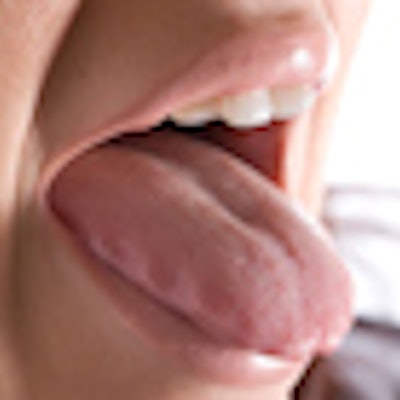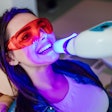
A 62-year-old woman with stubborn burning mouth syndrome (BMS) experienced a significant decrease in pain after taking the opioid antagonist naltrexone daily. The case report was published on April 30 in Oral Surgery, Oral Medicine, Oral Pathology and Oral Radiology.
Taking low-dose naltrexone (LDN) may offer a new way to treat this syndrome that produces a painful, chronic intraoral burning sensation but has no identifiable local or systemic cause. Improvements in the patient's hyposalivation also may have contributed to her decrease in pain intensity, the authors wrote.
"The present case report describes the use of LDN for the management of a patient with refractory BMS," wrote coauthor Dr. Linda Sangalli, PhD, MS, an orofacial pain resident at the department of oral health practice, division of orofacial pain, college of dentistry, University of Kentucky in Lexington.
62-year-old woman with burning on the tongue
After a tooth was pulled, the woman began experiencing burning pain coming from the extraction site. A trial of lidocaine mouthwash had no effect. A general dentist prescribed her clonazepam 1 mg daily, which provided limited pain relief.
In addition to the clonazepam, the woman took omeprazole, fluoxetine, fexofenadine, and zolpidem, according to the report. The woman had diagnoses of fibromyalgia, irritable bowel syndrome, headaches, depression, anxiety, and interstitial cystitis.
The burning resolved for a year but then returned at the dorsum of her tongue. The tongue pain was described as tingling and burning, and the intensity fluctuated from two in the morning to eight in the evening on a zero to 10 numerical rating scale (NRS), the authors wrote.
Talking, stress, dry mouth, and eating sugary foods aggravated the burning. Chewing gum and ice, eating and drinking, taking clonazepam, and toothbrushing relieved her symptoms.
Blood tests excluded any abnormalities in her levels of vitamins, electrolytes, autoimmune panel, thyroid hormone levels, and kidney function. A neurologist diagnosed her with BMS, according to the report.
Three years after her first complaint of burning mouth, the patient went to the University of Kentucky's Orofacial Pain Clinic with the same problem. After reviewing her medical history, a cranial nerve exam was conducted, but no abnormalities were found. An intraoral exam revealed a scalloped tongue, as well as severe generalized attrition, they wrote.
The woman's unstimulated salivary flow was 0.03 mL/min, and her stimulated salivary flow was 2.7 mL/min, and she scored a 10 on the xerostomia inventory short-form questionnaire, which is consistent with a clinical diagnosis of dry mouth. No other blood work was taken because the patient is monitored every six months for her other conditions, the authors wrote.
Considering the woman's hyposalivation level, her history, bloodwork, and exams, the diagnosis of BMS was confirmed, and hyposalivation was added as a potential contributing factor.
The woman was encouraged to increase her daily fluid intake (up to six to eight 8-oz. glasses of water); apply coconut oil to oral mucosa before meals; drink sugar-free noncarbonated drinks; and use sugar-free candies, gum, and lozenges. Increasing her clonazepam dose was suggested, but it was dismissed by the patient.
After discussions with her primary care doctor, the clinician at the oral pain clinic prescribed the patient naltrexone at bedtime daily. Evidence in one other case showed naltrexone may help with BMS.
After one month of taking 3 mg of naltrexone daily, the woman no longer had pain when she woke, and she reported a decrease in pain intensity of 50% in the evening. After two months at the same dosage, the patient denied any pain. At three months, her pain relief decreased, and her dose was adjusted to 4.5 mg. At six months, the patient rated her burning mouth pain at a two out of 10 on the NRS and improved further when she maintained her hydration, the authors wrote.
In this case, a bidirectional correlation between BMS and hyposalivation was observed. Sporadic increases in pain intensity occurred that were associated with poor hydration, they wrote.
Why it matters
The International Classification of Orofacial Pain defines BMS as an intraoral burning that recurs for more than two hours daily for more than three months without causative lesions. Up to 3.9% of the population, especially postmenopausal women, have BMS.
Clonazepam is proposed as an effective treatment, as well as tricyclic antidepressants, selective serotonin reuptake inhibitors, hormone replacement therapy, acupuncture, and cognitive behavioral therapy. Despite the many therapeutic options, the outcome often is unsatisfactory and does not cure BMS. Therefore, no treatments are necessary, the authors wrote.
In the future, more randomized controlled studies should be conducted to explore what role hyposalivation may play in the etiology of BMS to confirm the use of LDN as a viable treatment, the authors wrote.
"Daily LDN (4.5 mg) may be a feasible and effective treatment for patients who complain of intraoral burning, especially for those who are refractory to traditional treatment modalities," Sangalli and colleagues concluded.



















